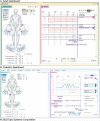Enhancing Care Partnerships Using a Rheumatology Dashboard: Bringing Together What Matters Most to Both Patients and Clinicians
- PMID: 36852527
- PMCID: PMC10100696
- DOI: 10.1002/acr2.11533
Enhancing Care Partnerships Using a Rheumatology Dashboard: Bringing Together What Matters Most to Both Patients and Clinicians
Abstract
Objective: Dashboards can support person-centered care by helping people partner with their clinicians to coproduce care based on preferences, shared decision-making, and evidence-based treatments. We engaged caregivers of children with juvenile idiopathic arthritis (JIA), adults with rheumatoid arthritis (RA), and clinicians in a pilot study to assess their experiences and the utility and impact of an electronic previsit questionnaire and point-of-care dashboard to support coproduction of rheumatology care.
Methods: We employed a mixed-methods design to assess users' perceptions of a customized electronic health record rheumatology module at four pediatric rheumatology practices and two adult rheumatology practices. We surveyed a convenience sample of caregivers of children with JIA (n = 113), adults with RA (n = 116), and clinicians (n = 12). We conducted semistructured interviews with 13 caregivers and patients and six care teams. Experiences were evaluated using descriptive statistics and thematic analyses.
Results: Caregivers of children with JIA and adults with RA reported the dashboards were useful during discussions (88%) and helped them talk about what mattered most (82%), make health care decisions (83%), and create a treatment plan (77%). Clinicians provided similar feedback. Two-thirds (67%) of caregivers and adults and 55% of clinicians would recommend the dashboard to peers. System usability scores (77.1 ± 15.6) were above average. Dashboards helped users make sense of health information, communicate more effectively, and make decisions. Improvements to the dashboards and workflows could enhance patient self-management and clinician efficiency.
Conclusion: Visual point-of-care dashboards can support caregivers, patients, and clinicians to coproduce rheumatology care. Findings demonstrate a need to spread and scale for broader benefit and impact.
© 2023 The Authors. ACR Open Rheumatology published by Wiley Periodicals LLC on behalf of American College of Rheumatology.
Figures


References
-
- Safiri S, Kolahi AA, Hoy D, et al. Global, regional and national burden of rheumatoid arthritis 1990‐2017: a systematic analysis of the Global Burden of Disease study 2017. Ann Rheum Dis 2019;78:1463–71. - PubMed
-
- Day AL, Curtis JR. Opioid use in rheumatoid arthritis: trends, efficacy, safety, and best practices. Curr Opin Rheumatol 2019;31:264–70. - PubMed
-
- Hibbard JH, Greene J. What the evidence shows about patient activation: better health outcomes and care experiences; fewer data on costs. Health Aff (Millwood) 2013;32:207–14. - PubMed

